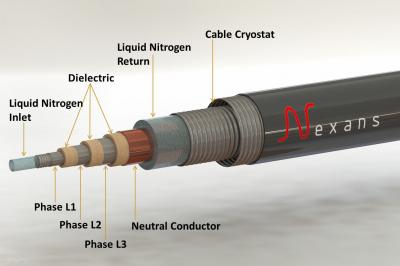Wire
Wires are pieces of metal that transport electricity. They are usually flexible which makes them easier to use. These electrical conductors are key to all electrical devices, from the electric circuit board in a computer to the transformer in a neighborhood, or even the electrical transmission system carrying electric power hundreds of kilometers. Without wires electricity would be unavailable for everyone, making them a necessary component to modern life. Depending on their purpose, wires can have varying sizes and compositions.
Wire gauge (size)
Differing cross sectional sizes of wires are known as wire gauges, they are organized by the American Wire Gauge system (AWG). Knowing the gauge is important because each is rated for a different ampacity, meaning that each wire size has a maximum electric current it can handle before damage (possibly serious) might occur. To read more on the American Wire Gauge system and how differing gauge sizes are utilized visit the wire gauge page.[1]
Composition

Most wires are coated in an insulating material in order to prevent electrocution when handling. Typically this insulating material is composed of plastic or rubber-like material. However, very large wires used for electrical power transmission aren't always insulated since they are far overhead and their danger is limited. Smaller wires are often made of ductile material so that they can bend and be bent easily.
Copper
Copper wire - the most commonly used conductive wire - is cost effective and offers a low resistivity (only silver has a lower resistivity but is very expensive). It is used in many commercial applications and therefore is widely available and comes in a variety of different gauges. Copper is quite ductile as well as being a good conductor, which is an added advantage for many applications.
Aluminum
Although aluminum wire is more cost effective than copper, its properties are not as favorable, it has a higher resistivity and has a lower elasticity (it's more plastic) meaning that if heated enough it expands and is more susceptible to diverging from its original shape once the heat is reduced.
Solid wires have only one conductive strand and are much more difficult to move or bend. They are typically used when a lot of movement isn't necessary[1] or when the wire is small (see figure 1).
Stranded wires contain a large number of thin solid wires that are wrapped around each other to make a single larger wire. They are much more flexible than solid wires and are often used when the wire undergoes frequent movement or manipulation[1] (see figure 1).
Superconductors

Wires made from superconductors can carry much higher electric currents than what is normally seen. For example, at the European Organization for Nuclear Research (CERN) a world record was recently set for maximum current transmission. Using two 20 meter cables of magnesium diboride (MgB2) - a superconducting material - cooled to 24 K (that's -249°C), a team was able to run 20 000 amperes (A) of current.[4] This number is huge when compared to the maximum seen in non-superconducting wires, which is around 380 - 400 A. The superconductor was able to carry approximately 50x more current! Superconductors are very advances materials and are may be useful for future electrical transmission systems.
For Further Reading
For further information please see the related pages below:
References
- ↑ 1.0 1.1 1.2 "Introduction to electricity" Pearson: Robert T. Paynter, B.J Toby Boydell
- ↑ Wikimedia Commons [Online], Available: https://commons.wikimedia.org/wiki/File:600V_CV_5.5sqmm.jpg#/media/File:600V_CV_5.5sqmm.jpg
- ↑ Phys.org. (Accessed July 30, 2015). World's longest superconductor cable [Online], Available: http://phys.org/news/2012-01-world-longest-superconductor-cable.html
- ↑ CERN. (Accessed July 30, 2015). World-record Current in a Superconductor [Online], Available: http://home.web.cern.ch/about/updates/2014/04/world-record-current-superconductor

